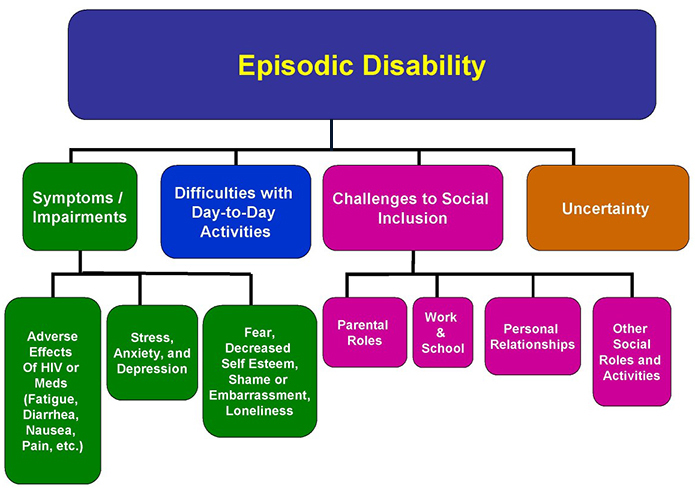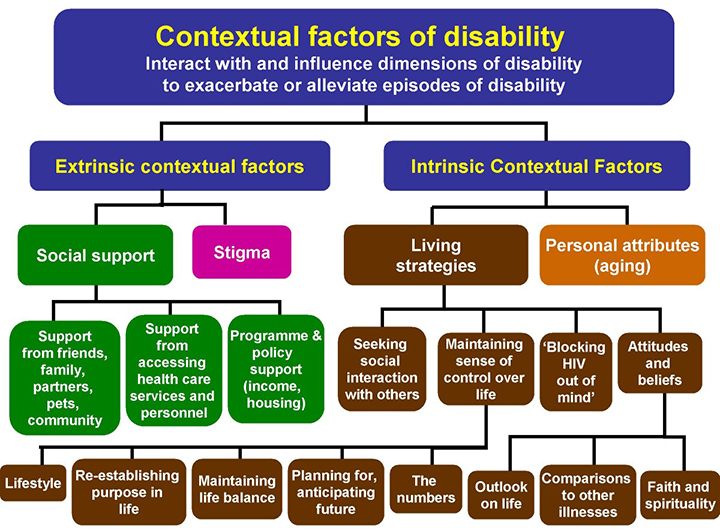1.4 – How can the Episodic Disability Model help us think about rehabilitation for people living with HIV?
For people who can access and tolerate ART, HIV is becoming a chronic and cyclical disease. These cycles of wellness and illness over time are not well captured in the ICF. Therefore, the Episodic Disability Model was developed with adults in Canada to describe the unpredictable nature of living with HIV.11,12
There is reason to expect that women, men and children on ART in sub-Saharan Africa will also experience episodes of wellness and illness related to their HIV.
The framework recognizes that each individual with HIV has her/his own disease course.
The Episodic Disability Model has 3 features:
- Dimensions of episodic disability which describe four dimensions of episodic disability and their sub-components that may be experienced by adults living with HIV (see Figure 1.4.1)
- Contextual factors of disability which describe the context in which disability is experienced. Extrinsic and intrinsic contextual factors could exacerbate or alleviate each of the four dimensions of disability for adults living with HIV (see Figure 1.4.2)
- Triggers or life events that can mark a major episode of disability (e.g., first receiving an HIV diagnosis, starting or changing medications, suffering the loss of a family member or friend) (see Figure 1.4.3)
Figure 1.4.1: Dimensions of Episodic Disability

O'Brien et al. Health and Quality of Life Outcomes 2008 6:76 doi:10.1186/1477-7525-6-76
Figure 1.4.2: Contextual factors of disability

O'Brien et al. Journal of the International AIDS Society 2009 12:30 doi:10.1186/1758-2652-12-30
Figure 1.4.3: Triggers

O'Brien et al. Health and Quality of Life Outcomes 2008 6:76 doi:10.1186/1477-7525-6-76
Why is it helpful to think about HIV as an episodic disability?
As people with access to ART live longer, the long-term impacts of HIV and its treatments (in combination with aging itself) may lead to increased prevalence of concurrent conditions, such as arthritis, fractures from osteoporosis, diabetes, some forms of cancer, and depression or other mental illnesses.13
- The common feature of these other conditions is that they can all be episodic both in nature and impact.
- As such, people living with HIV may experience several episodic conditions concurrently, all with different fluctuations in their functioning and health.
- Thus, the need for rehabilitation is expanding to prevent or manage such disabling impacts and promote quality of life.
This approach also helps to identify policy models that promote more flexible employment or school programs that enable people with episodic illnesses to participate when their health permits without losing the opportunity when they get sick again.
11O'Brien KK, Bayoumi AM, Strike C, Young NL, Davis AM. Exploring disability from the perspective of adults living with HIV/AIDS: development of a conceptual framework. Health Qual Life Outcomes. 2008a Oct 4;6:76. PubMed PMID: 18834538; PubMed Central PMCID:PMC2572592. http://www.ncbi.nlm.nih.gov/pubmed/18834538
12O'Brien KK, Davis AM, Strike C, Young NL, Bayoumi AM. Putting episodic disability into context: a qualitative study exploring factors that influence disability experienced by adults living with HIV/AIDS. J Int AIDS Soc. 2009 Nov 9;12(1):5. PubMed PMID: 19900284. http://www.ncbi.nlm.nih.gov/pubmed/19900284.
13Ernst J, Hufnagle KS, Shippy A. HIV and older adults. 2008. New York: AIDS Community Research Initiative of America.

 Previous Page
Previous Page




